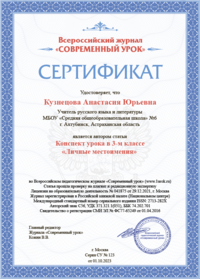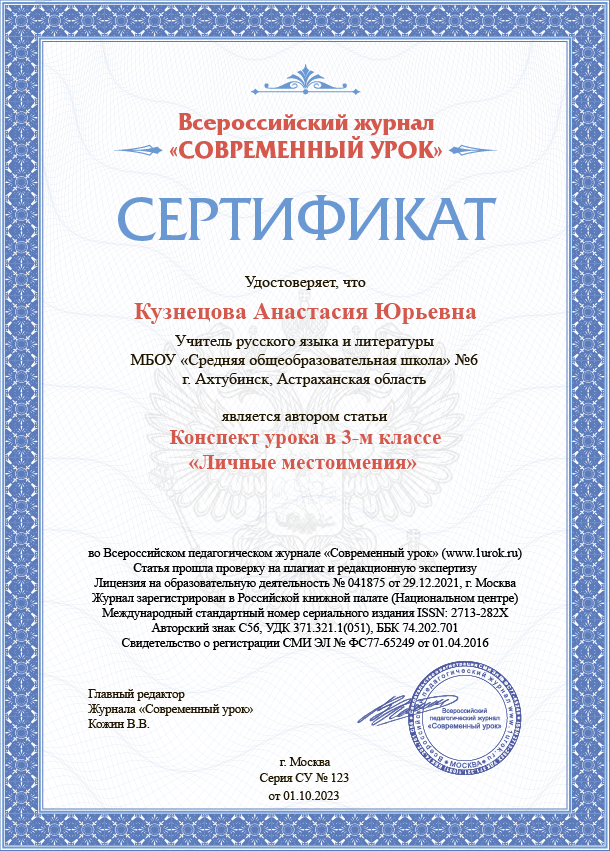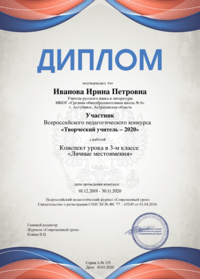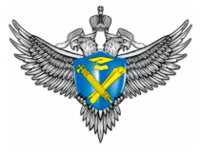Урок «Eating Habits» («Привычки в питании»)
Автор: Пряхина Екатерина Елисеевна
Организация: МБОУ «СОШ № 41 г. Чебоксары»
Населенный пункт: Чувашская Республика, г. Чебоксары
Eating habits. Привычки в питании.
1. Цели урока:
1.Обобщение и систематизация знаний по теме «Eating traditions and customs»
2.Создание условий для формирования и приобретения исследовательских умений учащихся, выработке самостоятельности и инициативы, способствующих развитию творческих способностей, .
2. Задачи:
практические: - развивать фонетические навыки, развивать навыки аудирования, развивать навыки письменной речи;
развивающие: - развивать память, развивать внимание, развивать готовности к коммуникации;
образовательные: - расширить кругозор, повысить общую культуру;
воспитательные: - воспитывать культуру общения; поддерживать интерес к учению, познавательной и творческой деятельности.
3. Методы и приемы: фонетическая и речевая разминка, фронтальный опрос, работа в группе, индивидуальная работа
4. Планируемые результаты: понимать лексические единицы по теме, выбирать требуемую информацию; понимать на слух текст, построенный на знакомом лексическом и грамматическом материале; умение рассказывать о своем любимом школьном предмете; делать обобщения на основе анализа изученного материала;
5. Оснащение: учебник, наглядный материал, раздаточный материал, видеозапись, мультимедийная презентация, телевизор.
Ход урока
1.Приветствие (слайд 1)
Учитель: Good morning, children! I’m glad to see you.
Доброе утро, дети! Я рада вас видеть.
Ученик (дежурный): We are ready for the English lesson. Today is the… of February. It’s Wednesday. (Names of pupils) are absent today.
Мы готовы к уроку английского языка. Сегодня … февраля, среда. (Имена учеников) сегодня отсутствуют.
Учитель: Hello dear pupils, you may take your seats.Let’s start our lesson.Today we are going to remember everything we discussed at the previous classes and speak about English, Russian traditional food, healthy eating habits.
Здравствуйте, дорогие ученики, вы можете сесть на свои места. Давайте начнем урок. Сегодня мы с вами вспомним все, что мы обсуждали на предыдущих занятиях и поговорим об английской и русской традиционной еде и здоровых пищевых привычках. (слайд1)
2.Речевая зарядка
Учитель: As usual, first let’s learn the English proverb. Today it will be: «After dinner comes the reckoning».
Как обычно сначала давайте изучим английскую пословицу. Сегодня это будет «После обеда приходится платить» (слайд 2)
Look at the screen and let's translate together.
Посмотрите на экран и давайте переведем ее вместе.
Дословный перевод- «После обеда приходится платить».
Now let’s think about the meaning of this proverb. Have you got any ideas?
Теперь давайте подумаем о значении этой пословицы. У вас есть идеи?
Ученики:
- There is no luck without a failure. Без потерь не бывает удачи.
- You can’t be happy without doing anything. Нельзя стать счастливым, ничего не делая.
- If you are happy today you must be ready for the hard time that may come tomorrow. Если сегодня вы счастливы, будьте готовы к тому, что завтра могут настать тяжелые времена.
Учитель: Thank you. You are right. Our life can’t consist of mere luck and pleasure. Success always has some other side: it is hard and everyday work. We must remember that lucky days don’t last forever. Daily routine follows each holiday. It’s just the rule that we must take without blaming anyone.
Спасибо. Вы правы. Наша жизнь не может состоять только из удач и удовольствий. У успеха всегда есть другая сторона: это тяжелый и ежедневный труд. Мы должны помнить удачные дни не длятся вечно. За каждым праздником следуют будни. Это лишь правило, которое мы должны принять.
And now let’s find Russian equivalent of this proverb.
А теперь давайте найдем русский эквивалент этой пословицы.
«Любишь кататься, люби и саночки возить»
«Не все коту масленица»
«Любишь медок- люби и холодок»
«То густо- то пусто»
«За все нужно платить»
Учитель: Today we are going to talk about our eating habits. Eating is one of the most important activities in everyone’s life. We enjoy eating - it’s an essential part of our life and a part of our culture; in fact, eating is the hottest universal topic of all times. We depend on eating: the food we eat is our energy and nutrition. We know so much about eating: we are born with the desire to eat and grow up with rich traditions of eating. But we also know so little about eating - about how the food we eat everyday influence our health.
Сегодня мы с вами поговорим о наших пищевых привычках. Питание играет одну из важнейших ролей в нашей жизни. Мы любим поесть. Еда - это неотъемлемая часть нашей жизни и часть нашей культуры. На самом деле питание – это одна из самых горячих тем во всем мире и на все времена. Мы зависим от еды: пища, которую мы едим - это наша энергия. Мы так много знаем о питании: мы рождаемся с желанием поесть и взрослеем в богатых традициях национальной кухни. Но в то же время мы мало знаем о еде - о том, как пища, которую мы потребляем каждый день, влияет на наше здоровье.
3.Повторение пройденного материала.
Аудирование. “Healthy eating habits”. «Здоровые пищевые привычки».
Учитель: I suggest listening to this report which will help us to learn some facts about healthy food. But first of all let’s learn some new words. Please repeat after me.
Я предлагаю вам прослушать доклад, который поможет нам узнать некоторые факты о здоровом питании. Но сначала давайте изучим новые слова.
Знакомство с новыми словами. Ученикам раздаются карточки с незнакомыми словами и их определениями на английском языке. Те же слова даны на экране. (слайд 3)
Просмотр видеозаписи (слайд 4).
Questions (вопросы): (слайд 5)
1. What are the main 4 factors of heart health? (total cholesterol, blood pressure, diet, body mass index). Какие 4 фактора влияют на здоровье сердца? (уровень холестерина, кровяное давление, диета, индекс массы тела)
2. How many children took part in the survey? What was their age? (9000, 2-11) Сколько детей приняло участие в исследовании? Какого возраста? ( 9000- 2-11)
3. What is the biggest problem according to the survey? (Kids do not eat right) В чем была самая большая проблема согласно исследованию? (Дети питаются неправильно)
4. What are the ways of solving the problem? ( planning of meals and physical activities) Каковы пути решения проблемы? (планирование приемов пищи и физическая активность).
4. Основной этап. (слайды 6-10)
Учитель: Different people eat different food. Today we have a great chance to meet a guest from the UK and she’d like to share information about traditional food in her country and learn more about our cuisine. So meet out guest who has come to us from Scotland. Please, come here.
Разные люди едят разную пищу. Сегодня у нас есть уникальный шанс познакомиться с гостем из Объединенного Королевства. Он хотел бы поделиться информацией о традиционной еде в его стране и узнать больше о нашей кухне. Итак, встречайте нашего гостя, который прибыл к нам из Шотландии. Пожалуйста, просим.
(Ученик-«гость» рассказывает о шотландской еде)
– Hello! I’m Brenda . I’m 12. I’m from Scotland. And today I would like to tell you about our national eating habits and to learn as much as possible about Chuvash Meals.Scottish eating habits has been greatly influenced by the cooking traditions of Great Britain. However, the Scottish dishes have its unique features. You will find fish, dairy products, fruits, vegetables, pork, lamb and beacon as the basic ingredients in many Scottish dishes. Haggis is one of the most popular dishes in Scotland. Prepared from the lungs, liver and heart of a sheep or calf, the dish is generally minced with oatmeal, seasoned with pepper and onion and boiled like a large sausage. The dish was also popular in England, until 18th century. Cullen Skink is another Scottish dish based on smoked fish and cream.. Black Bun is a special Scottish cake that is typically eaten on New Year’s Eve. The cake resembles a brick in form, a fruit-cake made of black currant wrapped in pastry which typically gets mature for several weeks.
Ученик-«гость»: And I’ll be pleased if you answer my questions. So, the first one:
И мне бы хотелось, чтобы вы ответили на мои вопросы. Итак, первый вопрос:
-What is a typical Chuvash Meal? Какая типичная еда в Чувашии?
Ученик 1: In Chuvashia, they prefer to eat meat dishes, mainly from lamb or pork, which is cooked with vegetables, and the most popular one of them is potato. There are also fish dishes on the menu, such as a fish cake, dumplings. Local people also like to pamper themselves with flour products. And since ancient times the Chuvash have been brewing their own national beer.
-What’s more popular? Что наиболее популярно?
Ученик 2: The most popular Chuvash dishes are: kakay-shurpe, puremech, shartan, huplu, fish in milk.
What is the most unusual dish? Какое самое необычное блюдо?
Ученик3 :The most famous and unusual national Chuvash dish of meat is shartan. It’s a beef stomach filled with minced heart, lungs, pepper and garlic boiled in salted water.
Thank you. And what is your favourite food? Спасибо. А какое твое любимое блюдо?
Ученик 4: As for me, I just adore huplu. It’s a yeast pie filled with potatoes, pork and onions.
Ученик-«гость»: Thank you very much. I’ve known a lot about Chuvash traditional food. And I can say that we have much in common in our eating traditions.
Спасибо большое. Я многое узнал о чувашской традиционной пище. И могу с уверенностью сказать, что у нас много общего.
- Thank you. It was so interesting. I’ve prepared a very small test to check how attentive you were. Спасибо. Это было очень интересно. Я подготовила небольшой тест, чтобы проверить, насколько внимательно вы слушали.
Quiz: (слайд 11)
1. What are the most popular Scottish dishes? Какие блюда наиболее популярны в Шотландии?
2. Name the Scottish dishes which are similar to the Chuvash meals. Назовите шотландские блюда, похожие на чувашские.
3. What is the main ingredient in a «black bun”? Какой главный ингредиент в «черной булке»?
5. Зарядка. (слайд 12)
6. Игры
Match the idioms with their meanings. Соедините идиомы с их значениями.(слайды 14-15)
|
|
1 – F, 2 – B, 3 – E, 4 – A, 5 – C, 6 – D, 7 – G, 8 – H, 9 — I
Find the odd word . Найдите лишнее слово. (слайды 16-17)
- A bowl of soup, cereal, cake.
- A carton of milk, orange juice, ham.
- A slice of bread, ham, flour.
- A packetof crisps, sugar, ketchup.
- A cup of tea, coffee, ice-cream.
- A glass of water, wine, butter.
- A box of chocolates, biscuits, vinegar
Say what it means Скажите, что это значит. ( слайды 18-19)
Grate – to cut (food) into very small pieces by rubbing it against a special tool (called a grater).
Grill – to cook (food) on a metal frame over fire.
Melt – to change or to cause (something) to change from a solid to a liquid usually because of heat. Like cheese.
Pour – to cause (something) to flow in a steady stream from or into a container or place.
Scramble – to prepare (eggs) by mixing the white and yellow parts together and then stirring the mixture in a hot pan.
Simmer – to cook (something) so that it is almost boiling for a certain period of time.
Spread – to put a layer of (something) on top of something else.
Stir – to mix (something) by making circular movements in it with a spoon or similar object.
Add – to put (something) with another thing or group of things.
Bake – to make (food, such as bread and cake) by preparing a dough, batter, etc., and cooking it in an oven using dry heat.
Blend – to mix (things) thoroughly and usually with good results.
Boil – to cook (something) in water that is boiling.
Cut – to use a sharp tool (such as a knife) to open or divide (something, such as paper or wood).
Fry – to cook (food) in fat or oil.
- Рефлексия (слайд 20)
T. So, guys,did you like our lesson? What did you like most of all? Please come to the blackboard and choose a fruit or a vegetable that shows your impression of our lesson. Put it into the basket please. So, our basket is full of cheerful fruit. I’m very glad that you’ve enjoyed our lesson today.
Your hometask will be to write down the recipe of your favourite dish. All of you will get excellent mark for this lesson. Thank you very much!
( на доске висят изображения корзины и фруктов-смайлов, выражающих различные эмоции.)
Ребята, вам понравился урок? Что вам понравилось больше всего? Пожалуйста выйдите к доске и выберите фрукт или овощ, который выражает ваше впечатление об уроке. И положите его в корзину.
Наша корзина полна веселых фруктов. Я рада, что вы хорошо провели время урока сегодня.
Домашнее задание будет написать рецепт вашего любимого блюда на английском языке. Все сегодня получают отличные оценки. Спасибо большое!
Список литературы и интернет-ресурсов:
1. М. И. Дубровин «Английские и русские пословицы и поговорки в иллюстрациях» ; Москва «Просвещение» 1995
2.https://yandex.ru/video/preview/?filmId=770098253681299210&url=http%3A%2F%2Fwww.youtube.com%2Fwatch%3Fv%3DKWbxKXD2EKE&text=Healthy%20Eating%20Habits&path=sharelink
3.https://yandex.ru/video/preview/?filmId=10553462560706378479&url=http%3A%2F%2Fwww.youtube.com%2Fwatch%3Fv%3DzkiEwtosCyE&text=%D0%97%D0%B0%D1%80%D1%8F%D0%B4%D0%BA%D0%B0%20%D0%B4%D0%BB%D1%8F%20%D0%B4%D0%B5%D1%82%D0%B5%D0%B9%20%D0%BD%D0%B0%20%D0%B0%D0%BD%D0%B3%D0%BB%D0%B8%D0%B9%D1%81%D0%BA%D0%BE%D0%BC%20%D1%8F%D0%B7%D1%8B%D0%BA%D0%B5&path=sharelink
4.https://theculturetrip.com/europe/united-kingdom/scotland/articles/16-foods-you-must-eat-in-scotland/
5.https://www.scotland.org/about-scotland/food-and-drink
6.https://chemodan-tour.ru/excursions-cheboksary/chuvashskaya-nacionalnaya-kuxnya/
7.https://yandex.ru/turbo/englishforbeginner.ru/s/leksika-na-temu-eda-food/
8. https://reallanguage.club/anglijskie-idiomy-pro-edu/
9. https://study-english.info/cooking-verbs.php

 БЕСПЛАТНЫЕ семинары
БЕСПЛАТНЫЕ семинары





